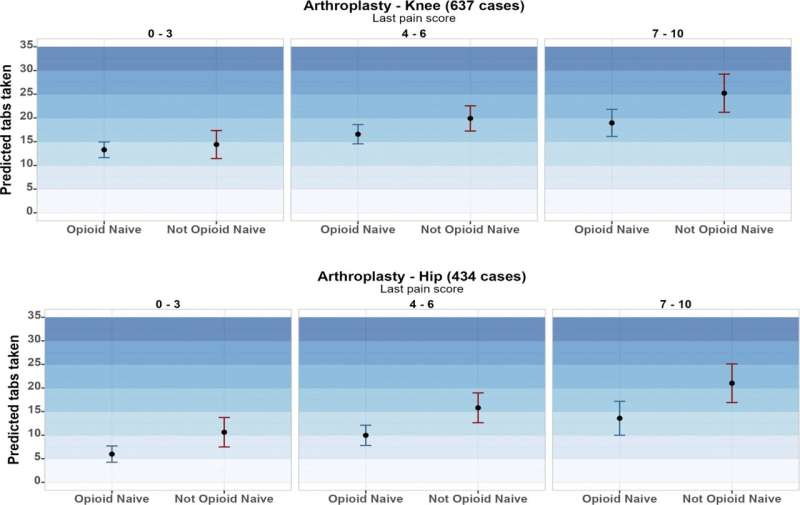This article has been reviewed according to Science X's editorial process and policies. Editors have highlighted the following attributes while ensuring the content's credibility:
fact-checked
trusted source
proofread
Pain scores, age can help identify patients more likely to use few or no opioids after surgery

Patients who are younger or who haven't taken opioid pain medication before are more likely to not need any after many common surgeries, according to new research from the Perelman School of Medicine.
Additionally, the study, published in Annals of Surgery Open, showed that simply understanding a patient's history with opioids and how they are feeling upon leaving the hospital could help clinicians tailor the amount of prescription pain medicines they may need as they transition home.
"At face value, it seems quite simple that asking patients about their pain and use of pain medicine would help inform what we do, but it is often easy to lose sight of the value of these patient-informed moments," said first author Anish Agarwal, MD, an assistant professor of Emergency Medicine and the deputy director of the Penn Medicine Center for Insights to Outcomes.
"These are simple data points, but they could be used in a high impact way to help manage pain, tailor prescribing, and support clinicians who are trying to better balance the risks of opioids while addressing expected pain following surgery."
The study, co-led by Kit Delgado, MD, an associate professor of emergency medicine and epidemiology and the director of the Penn Medicine Nudge Unit and co-chair of the Penn Medicine Opioid Task Force, used data collected through automated text messages sent to approximately 3,600 patients who had one of the 30 most common surgical procedures at the University of Pennsylvania Health System. Mostly, these surgeries fell under the umbrella of orthopaedic (such as hip or knee procedures) or neurosurgery (spine or back procedures).
Among the questions surgery patients were asked via text message were whether they filled their opioid prescription, their pain level on a scale of one to ten, how well they felt they could manage the pain, and how many opioid tablets they actually used.
"Previously, our team had used this automated text messaging program to generate procedure-specific guidelines, and these guidelines recommended a default quantity that would cover most patient needs, though most would need less and some needed more," Delgado said. "We wanted to use the data to identify some common factors that could guide clinicians to "right size" prescriptions based on a patient's personal characteristics."
Overall, of patients who hadn't taken opioids before (termed opioid naivety), more than half used either none or less than five of the opioid tablets they'd been prescribed. The researchers found that in hip replacements, patients who were opioid naïve and rated their pain low when being discharged used an average of about five opioid tablets while patients who had used opioids before and rated their pain high at discharge used an average of 20 tablets.
And in procedures where the hospitals' guideline was to prescribe 15 opioid tablets or fewer, patients who were in the lowest age bracket (18-34 years old) and who hadn't taken opioids before were significantly likely to not take any of the pain medication they were prescribed or, if they did, take just five tablets or fewer. The same held true in procedures where 20 opioid tablets were recommended.
Could it be possible that the opioid epidemic and new attention around it is affecting the way younger patients—who came of age during this time period—use pain medication?
"We know that clinicians are trying to prescribe fewer opioids and, anecdotally, we hear that patients have more concerns about opioid use," said Agarwal. "Nonetheless, there are instances where opioids, when taken in limited quantities and for short periods, are effective tools to help patients manage severe pain—for instance after a major surgery. We're hoping this work can alleviate some concerns, as well as some of the issues surrounding leftover medications."
Because the researchers found a correlation between use of opioids and the severity of pain that patients reported upon discharge, the researchers believe that simple measures can be used in the moment by clinicians to help adjust prescriptions to specific patient needs. For example, if a patient reports their pain as a "3," giving them the same amount of opioids as a patient rating their pain an "8" may not be necessary. And, by extension, that could help cut down on the leftover opioids after surgeries that can be misused and circulated.
For example, in hip replacements, again, the opioid naïve, low-pain patients only needed about five tablets of opioids. But opioid naïve patients who underwent the same procedure and rated their pain as high needed almost 15 tablets, on average.
This research extends other work by Agarwal, Delgado, and their colleagues seeking to cut down on the possibilities of having leftover opioids after surgeries. That includes mailing order disposal kits and using a texting program similar to the one in this study to monitor how many opioids patients used, in real-time.
"The next steps here are to take this research and translate it into actual clinical practice," Agarwal said. "We've already used the feedback from our patients to help support our existing guidelines, and with this data our clinicians can become even more specific to personalize the approach to pain management for patients. We are beginning to see opportunities to help create new pathways for clinical decision support across large systems and for thousands of patients, but in a way that is still personalized based on their history and pain trajectory."
More information: Anish K. Agarwal et al, Identifying Patient Characteristics Associated With Opioid Use to Inform Surgical Pain Management, Annals of Surgery Open (2023). DOI: 10.1097/AS9.0000000000000355





















